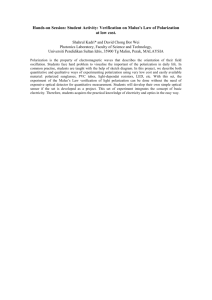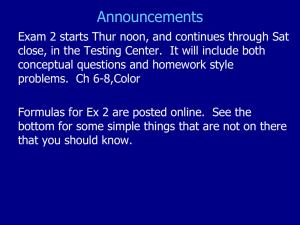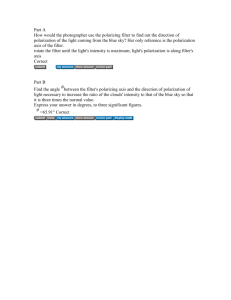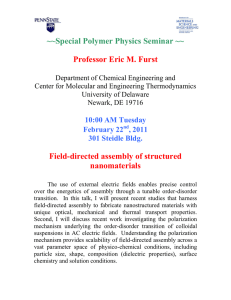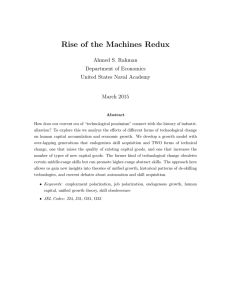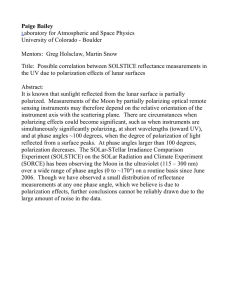WMAP Polarization: Lessons Learned (to date) Gary Hinshaw
advertisement
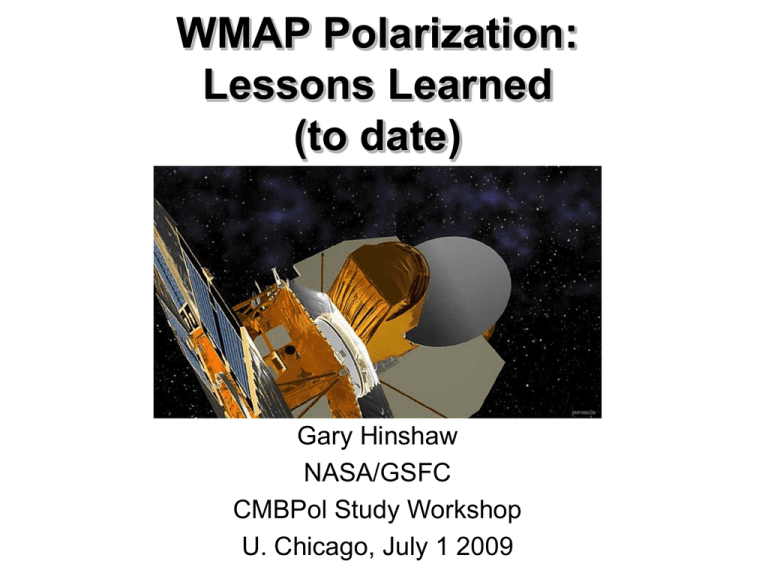
WMAP Polarization:
Lessons Learned
(to date)
Gary Hinshaw
NASA/GSFC
CMBPol Study Workshop
U. Chicago, July 1 2009
WMAP Collaborators
Charles Bennett
Rachel Bean
Olivier Dore
Jo Dunkley*
Ben Gold
Michael Greason
Mark Halpern*
Robert Hill
Gary Hinshaw*
Norman Jarosik
Al Kogut*
Eiichiro Komatsu
David Larson*
Johns Hopkins (P.I.)
Cornell
CITA/Toronto
Oxford
U. Minnesota
NASA/GSFC
UBC
NASA/GSFC
NASA/GSFC
Princeton
NASA/GSFC
U. Texas
Johns Hopkins
* Present at this meeting
**Dave Wilkinson
Michele Limon
Stephen Meyer*
Mike Nolta
Nils Odegard
Lyman Page
Hiranya Peiris
Kendrick Smith*
David Spergel
Greg Tucker*
Licia Verde
Janet Weiland
Edward Wollack
Ned Wright
***
Columbia
U. Chicago
CITA/Toronto
NASA/GSFC
Princeton
Cambridge
Cambridge
Princeton
Brown
Barcelona
NASA/GSFC
NASA/GSFC
UCLA
WMAP Launch
8 years + 1 day in space.
June 30, 2001, 15:46:46 EDT
Delta II Model 7425-10
Delta Launch Number 286
Star-48 third stage motor
Cape Canaveral Air Force Station
Pad SLC-17B
WMAP Details
Angular resolution (FWHM)
48, 37, 29, 20, 12
arcminutes
Frequency Coverage
23, 33, 41, 61, 94
GHz (K,Ka,Q,V,W)
Sky Coverage
41253 (full)
square degrees
Multipole Coverage
2 to ~200
(sensitivity-limited)
Polarization Modulation?
limited
Types of Detectors
coherent (HEMT)
Location
L2
space
Instrument NEQ*
520,532,515,618,743
K s1/2
Current limit on r**
<0.43, <0.20
Status
9 years of operation
(see later)
-
(WMAP, WMAP+BAO+SN)
(funded)
* Based on measured noise per differential observation. Co-added results for Q, V, W bands.
**Current r limits based on 5-year TT spectrum shape - approaching confusion limit of r~0.1 for TT.
Cleaned TT spectrum based on template-cleaned V+W data and Q+V+W-based residual source
subtraction.
Data rate: 8 channels @ 128 ms, 8 @ 102.4 ms, 8 @ 76.8 ms, 16 @ 51.2 ms for 9 years.
WMAP Systematic Error Table
Effect
Notes
Cross-polar beam
EB
sensitivity-limited
Polarization angle errors
EB
“
Pointing errors (on Q/U)
EB
“
Main beam asymmetry (before
differencing)
dT B
cross-polar?
Sidelobes
dT B
Barnes et al, ApJS, 148, 51 (2003)
Instrumental polarization
dT B
see 1/f noise
Relative calibration errors
dT B
subdominant to baseline errors
Pointing errors before differencing
TB
n/a
Gain drift before differencing
TB
see relative calibration
Optics and spillover T variations
dTopt B
Hinshaw et al., ApJS, submitted
Scan modulated cold stage variations
dTCS B
subdominant to optics variations
foregrounds B
potentially significant to B modes,
modulate polarization angle
“noise” E,B
offset/baseline drifts
Systematic
Band shape errors, including modulator
effects
Others?
WMAP Optics - I
•
Back-to-back Gregorian telescope:
– 1.4 x 1.6 m primaries, shaped
– composite construction: Korex honeycomb core, carbon-fiber face sheets, VDA
(2.5 um) / SiOx (2.2 m) coating
•
10 corrugated feeds per side:
– 1 ea @ K, Ka (profiled); 2 ea @ Q, V, 4 ea @ W band (extended)
•
Ortho-mode Transducers (OMTs):
– splits polarization response to 2 separate radiometers
– polarization angles measured by metrology to ±0.2°, by radiometry to ±1.0°
– cross-polar response at peak of main beam: < -25, -27, -24, -25, -22 dB (K-W)
Page et al., ApJ, 585, 566 (2003)
WMAP Optics - II
•
Modeled vs. measured
beam response:
– A-side optics
– Broadband response
(from 12 frequencies)
– Data taken in warm
chamber, pre-flight
– In-flight optics are more
distorted and required
further modeling to
establish -40 dB tails
Jarosik et al., ApJS, 170, 263 (2007)
Hill et al., ApJS, in press (2008)
WMAP Pointing Accuracy
•
WMAP spacecraft frame primarily determined by star trackers
–
–
–
•
Pointing reconstruction better than 5 arcsec in tracker frame.
Tracker mount flexes ~1 arcmin (on an annual time scale) relative to feed
frame due to thermal flexure of spacecraft top deck. Effect is modeled with
an accuracy of ~0.1 arcmin.
Instrument lines-of-sight measured with respect to spacecraft frame by
centroiding Jupiter observations. Accuracy also ~0.1 arcmin per beam.
Beams differenced in polarization measurement (radiometers 1 and 2)
are always launched by the same feed, so are always relatively coaligned.
In general, optical and pointing imperfections (which convert E mode to B
mode) are subdominant for WMAP due to our relatively low signal-tonoise. We currently see no hint of B-modes after foreground cleaning.
Larger concerns are aliasing of T to E, and accurate characterization of full
errors at low-l.
WMAP Radiometers
•
Differential, pseudo-correlation, polarization-sensitive:
– 2 sky ports (A side and B side),
– phase-matched HEMT amplification,
– polarization measured by separate radiometers
•
Signal modulation:
– 2.5 kHz phase switch after warm HEMT; mitigates 1/f noise, does not modulate
polarization signal,
– 0.464 rpm spacecraft spin; modulates polarization, but P signal does not “spin
flip” like T signal does due to A/B side OMT orientation
– 1.0 rph spacecraft precession
Jarosik et al., ApJS, 145, 413 (2003)
radiometer 1
radiometer 2
WMAP Band Definition
•
Set by combination of HEMT gain profile and band definition filter
– Will in general be slightly different between two radiometers (i.e., polarization
channels),
– Signal response per radiometers calibrated to CMB dipole with 2.7K blackbody
spectrum,
– Sky signals with different spectrum (i.e., foreground signals) will produce a
spurious polarized response,
– Distinguish from sky polarization by modulating polarization angle (see next)
– Include a “spurious” sky map in the sky model
Jarosik et al., ApJS, 145, 413 (2003)
Worst case
WMAP Polarization Modulation
More details please...
WMAP Scan Strategy - I
Not to scale:
Earth — L2 distance is
1% of Sun — Earth Distance
22.5° half-angle
1 hour precession cone
3 Months
129 sec. (0.464rpm) Spin
A-side line of site
MAP at L2
6 Months full sky coverage
Earth
Sun
B-side line of site
1 Day
WMAP Scan Strategy - II
•
Polarization angle modulation:
– Ecliptic plane: ±22.5° once per hour in middle of annulus (slow),
– Ecliptic poles: ±180° over 6 month period (very slow)
•
Polarization signal modulation:
– Complicated, depends on spherical harmonic mode (see next)
WMAP Signal Modulation
• Radiometers 1 and 2 measure (ignoring loss
imbalance):
d1 T P
T 12 (d1 d 2 )
d 2 T P
P 12 (d1 d 2 )
Note: d1 & d2 are calibrated independently
T TA TB
P (QA cos 2 A U A sin 2 A ) (QB cos 2 B U B sin 2 B )
• The term ΔT changes sign on spin flip, but in general,
ΔP does not, so the polarization measurement is more
sensitive to offset (or baseline) variations than the
temperature measurement is, especially l=3 BB.
• See sample time-ordered data plots (DT_QU = ΔP )
WMAP Polarization Modulation: l=2
E (l=2,m=1)
B (l=2,m=1)
1 hour
WMAP Polarization Modulation: l=3
E (l=3,m=1)
B (l=3,m=1)
WMAP Polarization Modulation: l=4
E (l=4,m=1)
B (l=4,m=1)
WMAP Polarization Modulation: l=5
E (l=5,m=1)
B (l=5,m=1)
WMAP Baseline Processing
•
WMAP instrument baseline due to a combination of relatively fixed
instrument asymmetries (some with slow thermal dependence) and 1/f
noise.
•
On time scale longer than 1 hour, baseline parameters are fit and removed
(see later). On time scales less than 1 hour, data are optimally filtered
using a ~1/f noise model.
•
The 1/f noise model must be accurately propagated from the time-ordered
data to the sky map weight matrix:
1 ( p1 , p2 ) M T N 1M M (t1 , p1 ) N 1 (t1 t2 )M (t2 , p2 )
t1 ,t 2
•
MUCH effort has been expended to carry this out for WMAP. We produce
a pixel-pixel weight matrix at low resolution (HEALPix Nside = 16). We
propagate this to power spectrum estimation using both pseudo-Cl and
maximum likelihood methods.
•
We test the error propagation by comparing the predicted errors to the
scatter observed in the year-to-year data. In most cases the agreement is
quite good (see next).
WMAP Power Spectrum Errors
Black –
errors computed
using full pixelpixel covariance
Red –
errors computed
assuming sky
map noise is
diagonal (no
pixel-pixel
covariance)
Sawtooth
structure mostly
arises from scan
geometry. 1/f
noise elevates
the overall level.
Page et al. ApJS,
170, 335 (2007)
How Well do the Errors Work?
•
•
Very well for Ka, Q, V bands, as measured by year-year scatter.
(K band is used as a foreground template.)
Very well for W band for l > ~10.
Reasonably well for W band,
l<10 with some exceptions:
• l=2,3 BB: too much yearyear scatter. Sign of
baseline problems??
• l=7 EE: spot-on year-year
scatter, but a “significant”
co-added result (see left)
Calibration / sky map covariance - I
Simplest form of map-making problem:
2 ( g k ti bk ) 2 / i2
i
• gk, bk: calibration parameters (gain, baseline in interval k)
t = IA-IB : differential temperature (intensity I) at time ti
(general case includes polarization, Q, U)
•
Full sky map solution employs iterative solution of non-linear system:
– fix [I,Q,U], solve gk, bk
– fix gk, bk, solve [I,Q,U]
– etc.
,
•
This approach does not give sky map errors that account for covariance
between sky signal and calibration parameters.
•
Attempt to assess fully covariant errors for low-l sky signal using a small
number of calibration and sky signal parameters.
Calibration / sky map covariance - II
Evaluate covariance matrix of calibration and sky map errors by evaluating 2nd
derivative,
2 2
Fab
pa pb
at the values given by the iterative solution, then inverting.
•
Restricted parameter set {pa}:
–
–
•
gk, bk: calibration parameters (gain, baseline in 1-hour intervals k), 2 · 8766 / yr
[I,Q,U] → almTEB ; l=1-10, 3 · (lmax+1)2
Each matrix element requires a sum over the time-ordered data.
(D. Larson, M. Greason)
•
Invert full matrix Fab and sky-only submatrix F´ab to obtain two estimates of σlmTEB,
with and without accounting for calibration error.
•
Compare ratio of σlmTEB mode by mode to assess affect of calibration covariance
•
Subsequent plots show gain-only, baseline-only, and combined affect for l=1-10.
Effect of gain covariance
T
alm
l 1 10
E
alm
l 2 10
B
alm
l 2 10
Effect of baseline covariance
T
alm
l 1 10
E
alm
l 2 10
B
alm
l 2 10
Effect of gain+baseline covariance
T
alm
l 1 10
E
alm
l 2 10
B
alm
l 2 10
Calibration / sky map covariance - III
Still to do:
• Map the σlmTEB ratios to the pixel-pixel weight
matrix, N-1pp´, @Nside=16
• Re-generate low-l cut-sky spectra with
modified weights.
• Re-generate low-l Fisher Cl errors with
modified weights.
• Maybe l=7 EE error pops up after all that?
(Seems unlikely.)
Issues/Lessons/Concerns
Polarization signal modulation is critical!
If you don’t modulate it, you can’t measure it
(unless your instrument is perfect).
The End
WMAP @ L2
Taken with ESO 2.2 m
telescope, La Silla Chile, for
GAIA optical tracking test.
3 images (R,G.B) taken a
few minutes apart, V=19.4.
WMAP Polarization Modulation: l=6
WMAP Polarization Modulation: l=7
Instrument and Observing Strategy
Please describe the following items, as well as anything else we need to
know to understand how you’re going to make polarization maps
•
•
•
•
•
•
Optics
band definitions
polarization selection
Polarization modulation
Scan strategy
Pointing reconstruction (accuracy)
